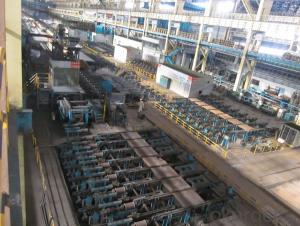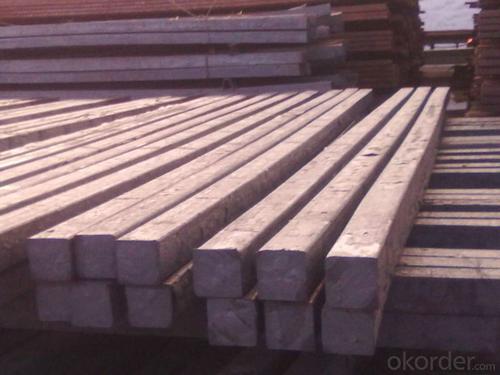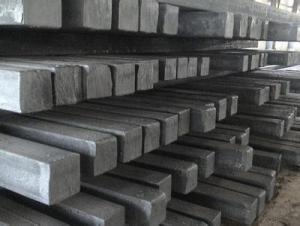Hot Rolled Square Steel Billet 3SP Standard 95mm
- Loading Port:
- Shanghai
- Payment Terms:
- TT OR LC
- Min Order Qty:
- 2000 m.t.
- Supply Capability:
- 10000 m.t./month
OKorder Service Pledge
OKorder Financial Service
You Might Also Like
Structure of Hot Rolled Square Steel Billet 3SP Standard 95mm

Description of Hot Rolled Square Steel Billet 3SP Standard 95mm
PPGI is made by cold rolled steel sheet and galvanized steel sheets as baseplate, through the surface pretreatment (degreasing, cleaning, chemical conversion processing), coated by the method of continuous coatings (roller coating method),
and after roasting and cooling. Zinc coating: Z60, Z80, Z100, Z120, Z180, Z275, G30, G60, G90
Alu-zinc coating: AZ60, AZ80, AZ100, AZ120, AZ180, G30, G60, G90

Main Feature of Hot Rolled Square Steel Billet 3SP Standard 95mm
1) Excellent corrosion resistance: The zinc layer provides a good protection of Pre-painted Galvanizeed Steel Sheet.
2) High heat resistance: The reflective surface of the material aids in efficiently reflecting the sunlight away and in turn reducing the amount of heat transmitted. The thermal reflectivity converts into energy savings.
3) Aesthetics: Pre-Painted Galvanized steel sheet is available in plethora of patterns and multiple sizes as per the requirements that given by our customers.
4) Versatility: can be used in the various areas.Standard seaworthy export packing: 3 layers of packing, inside is kraft paper, water plastic film is in the middle and outside GI steel sheet to be covered by steel strips with lock, with inner coil sleeve.
Applications of Hot Rolled Square Steel Billet 3SP Standard 95mm
1) Automotive bodies: filters, fuel tanks, etc.
2) Construction materials: roofings, welding pipes,
3) Electric and electronic appliances: computer cans, etc.
4) Steel cans: containers, etc.
5) Steel furniture: washing machines, refrigerators, microwaves, etc.
6) Drums
7) Office equipment: printer, recorders, etc.
8) Motors and transformers

Specifications of Hot Rolled Square Steel Billet 3SP Standard 95mm
| Classified symbol | Yield Point Minimum N/mm2 | Tensile Strength Minimum | Elongation Minimum % | Application | ||||
| N/mm2 | Nominal Thickness mm (t) | |||||||
| JIS | Yogic | 0.25-0.4 | 0.4-0.6 | 0.6-1.0 | 1.0-1.6 | |||
| G3312 | specification | |||||||
| CGCC | CGCC | -205 | -270 | -20 | -21 | -24 | -24 | Commercial |
| CGCD | CGCD | --- | 270 | --- | 27 | 31 | 32 | Drawing |
| --- | CG340 | 245 | 340 | 20 | 20 | 20 | 20 | Structural |
| CGC400 | CG400 | 295 | 400 | 16 | 17 | 18 | 18 | Structural |
| CGC440 | CG440 | 335 | 440 | 14 | 15 | 16 | 18 | Structural |
| CGC490 | CG490 | 365 | 490 | 12 | 13 | 14 | 16 | Structural |
| CGC570 | CG570 | 560 | 570 | --- | --- | --- | --- | Structural |
| ASTM Designation | Yield Point Minimum | Tensile Strength Minimum | Elongation Minimum % | Application | Q/BQB 445-2004(China standard) | ASM A653/A653M | JISG 3312 | |
| ksi(MPa) | ksi(MPa) | TDC51D+Z | (CS TYPE A+Z) | CGCC | ||||
| A653(M)-99 CS TYPE A,B,C | --- | --- | --- | Commercial | TDC52D+Z | CGCD | ||
| A653(M)-99 FS | --- | --- | --- | Lock Forming | TS250GD+Z | (G250+Z) | - | |
| A653(M)-99 DS | --- | --- | --- | Drawing | TS300GS+Z | (G300+Z) | CGC 400 | |
| A653(M)-99 SS Grade33(230) | 33(230) | 45(310) | 20 | Structural | TS350GD+Z | (G350+Z) | CGC490 | |
| A653(M)-99 SS Grade37(255) | 37(255) | 52(360) | 18 | Structural | TS550GD+Z | (G550+Z) | CGC570 | |
| A653(M)-99 SS Grade40(275) | 40(275) | 55(380) | 16 | Structural | ||||
| A653(M)-99 SS Grade50(345) | 50(345) | 65(450) | 12 | Structural | ||||
| A653(M)-99 SS Grade80(550) | 80(550) | 82(570) | --- | Structural | ||||
FAQ of Hot Rolled Square Steel Billet 3SP Standard 95mm
We have organized several common questions for our clients,may help you sincerely:
1. How Can I Visit There?
Our company is located in Tianjin City, China, near Beijing. You can fly to Tianjin Airport Directly. All our clients, from home or aboard, are warmly welcome to visit us!
2. How Can I Get Some Sample?
We are honored to offer you sample.
3. Why choose CNBM?
1, ISO, BV, CE, SGS approved.
2, Competitive price and quality.
3, Efficient service team online for 24 hours.
4, Smooth production ability(50000tons/month) .
5, quick delivery and standard exporting package.
6, Flexible payment with T/T, L/C, Paypal, Kunlun bank, etc .
- Q: How are steel billets used in the manufacturing of pipeline fittings?
- Steel billets are used in the manufacturing of pipeline fittings by being heated and shaped into the desired form. They serve as the raw material that is then further processed and machined to create various types of fittings such as elbows, tees, reducers, and flanges. The steel billets undergo a series of forging, cutting, and welding processes to achieve the required dimensions and specifications for the pipeline fittings.
- Q: How are steel billets used in the manufacturing of power plant equipment?
- Steel billets are used in the manufacturing of power plant equipment as they serve as the raw material for various components such as turbine blades, shafts, and boiler tubes. These billets are shaped and machined to form the specific parts needed for power generation, ensuring strength, durability, and high-performance capabilities in the harsh operating conditions of power plants.
- Q: How are steel billets different from steel ingots?
- Steel billets and steel ingots, although both semi-finished steel products, vary in their shape, size, and manufacturing process. To begin with, the shape of steel billets and steel ingots differs. Steel billets generally have a square or rectangular shape, with dimensions determined by production requirements. Conversely, steel ingots possess a more irregular shape, often resembling a large block or loaf. The mold used for casting determines the shape of the ingot. Furthermore, the size of steel billets and steel ingots also varies. Billets are typically smaller in size compared to ingots. They are produced with smaller cross-sectional areas and lengths, making them suitable for further processing. In contrast, steel ingots are larger and heavier, as they are cast in molds capable of accommodating a greater volume of molten steel. Finally, the manufacturing process for steel billets and steel ingots differs. Steel billets are typically produced through continuous casting, a process in which molten steel is poured into a water-cooled mold to solidify into the desired shape. This method allows for controlled and efficient production of billets. On the other hand, steel ingots are generally produced through casting in open or closed molds, where the molten steel is poured and left to solidify. This process tends to be slower and less precise compared to continuous casting. In conclusion, steel billets and steel ingots differ in terms of their shape, size, and manufacturing process. Billets are square or rectangular in shape, smaller in size, and produced through continuous casting, whereas ingots possess an irregular shape, larger in size, and are produced through casting in molds. Both products serve as crucial raw materials for the production of various steel products.
- Q: How do steel billets contribute to the strength of a structure?
- Steel billets contribute to the strength of a structure in several ways. Firstly, steel billets are produced by a process called casting, which involves pouring molten steel into molds and allowing it to solidify. This method ensures that the steel billets have a consistent and uniform composition, with minimal impurities. As a result, the structural integrity and strength of the final product are enhanced. Secondly, steel billets undergo a process called hot rolling or cold rolling, which further improves their strength. Hot rolling involves heating the steel billets to high temperatures and then passing them through a series of rollers, which compress and shape the steel into the desired form. This process helps align the steel's grain structure, making it stronger and more resistant to deformation. Additionally, steel billets are often used as raw material for the production of other steel products, such as beams, columns, and plates. These fabricated steel components are then incorporated into structures, providing additional strength and support. The high strength and durability of steel billets make them ideal for withstanding heavy loads, seismic forces, and other external pressures. Moreover, steel billets can be alloyed with other elements, such as carbon, manganese, and chromium, to enhance their mechanical properties and increase their strength. The addition of these alloying elements improves the steel's hardness, toughness, and resistance to corrosion, making it even more suitable for structural applications. Overall, steel billets play a crucial role in enhancing the strength of a structure. Through their uniform composition, hot or cold rolling processes, and alloying capabilities, steel billets contribute to the overall structural integrity, durability, and load-bearing capacity of buildings, bridges, and other infrastructure projects.
- Q: What are the causes of internal cracks in continuous casting billet?
- A French Research Institute of carbon, sulfur and phosphorus influence on continuous casting billet hot cracking, a total of three test groups of carbon manganese steel, carbon, sulfur and phosphorus content of each sample is different. The test according to the process of the sample for cooling, in order to study the effects of the three elements of the internal crack of continuous casting billet hot.
- Q: How do steel billets contribute to the manufacturing of consumer goods?
- Steel billets play a crucial role in the manufacturing of consumer goods by serving as the raw material for a wide range of products. These billets are essentially semi-finished steel products that are created through the casting process. They are solid blocks of steel that are heated and then shaped into a specific form, which can vary depending on the intended application. One of the primary ways steel billets contribute to the manufacturing of consumer goods is through their use in the production of various metal parts. These parts can be found in a multitude of products, such as automobiles, appliances, machinery, and furniture. By using steel billets as the starting material, manufacturers can create components that are strong, durable, and resistant to wear and tear. This ensures that the final consumer goods have a long lifespan and can withstand the demands of everyday use. Furthermore, steel billets are often used in the construction industry for the production of structural steel beams, columns, and other building materials. These components are crucial for the construction of infrastructure, residential buildings, commercial complexes, and other structures. Steel's high strength-to-weight ratio makes it an ideal material for these applications, providing the necessary structural support while minimizing the overall weight and cost. In addition to their strength and durability, steel billets also offer versatility in terms of their formability and machinability. This means that they can be easily shaped, welded, and cut into various sizes and designs, allowing manufacturers to tailor the steel components to meet specific consumer needs. This flexibility enables the production of a wide range of consumer goods, from small intricate parts to large complex structures. The use of steel billets in the manufacturing of consumer goods also contributes to sustainability. Steel is a highly recyclable material, and the production of steel products using recycled steel requires significantly less energy and resources compared to using virgin materials. This helps reduce the environmental impact associated with consumer goods production and promotes a more circular economy. Overall, steel billets are a crucial ingredient in the manufacturing of consumer goods. Their strength, durability, versatility, and recyclability make them an ideal material choice for producing a wide range of products that meet the needs and expectations of consumers.
- Q: What is carbon accumulation?
- Generally refers to the polycarbonate, PC, is a kind of thermoplastic plastics, good transparency, good mechanical properties, surface hardness, common uses such as CD, plastic glasses, a fence, protective window, public places, vacuum cleaners, coffee machine, juicer barrel, refrigerator shelf, pure such as the bucket.
- Q: What are the different surface treatments for improved weldability in steel billets?
- There are several surface treatments that can be used to improve weldability in steel billets. These include processes such as pickling, grinding, and shot blasting. Pickling involves removing any surface impurities or oxides through the use of acid solutions. Grinding helps to smooth out any rough or uneven surfaces, ensuring better contact and fusion during the welding process. Shot blasting uses high-speed projectiles to clean the surface and create a rough texture, which enhances the adhesion of the weld. These treatments help to remove contaminants and improve the overall quality and weldability of the steel billets.
- Q: Are steel billets used in the production of furniture?
- Typically, furniture production does not involve the use of steel billets. Steel billets are actually semi-finished products derived from molten iron and are later transformed into various shapes like bars, rods, or sheets through a process known as hot rolling. While furniture may incorporate steel, it is usually in the form of finished products such as steel tubing, steel sheets, or steel frames. These finished steel products are more commonly employed in constructing furniture, especially in industrial or modern designs. Incorporating steel in furniture manufacturing offers durability, strength, and a sleek appearance. Nonetheless, the steel used in furniture production is usually obtained through different methods compared to the production of steel billets.
- Q: What are the properties and characteristics of steel billets?
- Steel billets, typically utilized in the production of various steel products, exhibit numerous properties and characteristics that render them suitable for such applications. To begin with, their exceptional strength-to-weight ratio endows steel billets with immense strength, enabling them to withstand heavy loads. This strength is derived from the steel's carbon content, which enhances its structural integrity. Furthermore, their superb heat conductivity facilitates efficient heat transfer during diverse manufacturing processes. Consequently, steel billets prove ideal for applications involving high-temperature operations, such as forging and rolling. Moreover, their remarkable machinability enables easy shaping and forming into desired products. This property is of utmost importance in the manufacturing industry, as it allows for the production of intricate and personalized steel components. Steel billets also possess outstanding ductility, enabling them to stretch and mold without fracturing. This characteristic proves vital in applications requiring bending or forming the steel into various shapes. In addition, steel billets exhibit a high resistance to corrosion, rendering them suitable for outdoor or corrosive environments. This property guarantees the durability and longevity of steel products manufactured from billets. Furthermore, steel billets can be effortlessly welded, facilitating the fabrication of large and intricate structures. Their weldability renders them versatile and adaptable to diverse construction and manufacturing needs. Lastly, steel billets boast a consistent and uniform composition, ensuring the production of high-quality and dependable steel products. This consistency is achieved through meticulous manufacturing processes and rigorous quality control measures. To conclude, steel billets possess numerous properties and characteristics that make them highly sought-after in the production of steel products. Their high strength, heat conductivity, machinability, ductility, corrosion resistance, weldability, and consistent composition deem them indispensable in various industries, including construction, automotive, and manufacturing.
Send your message to us
Hot Rolled Square Steel Billet 3SP Standard 95mm
- Loading Port:
- Shanghai
- Payment Terms:
- TT OR LC
- Min Order Qty:
- 2000 m.t.
- Supply Capability:
- 10000 m.t./month
OKorder Service Pledge
OKorder Financial Service
Similar products
Hot products
Hot Searches
Related keywords






























